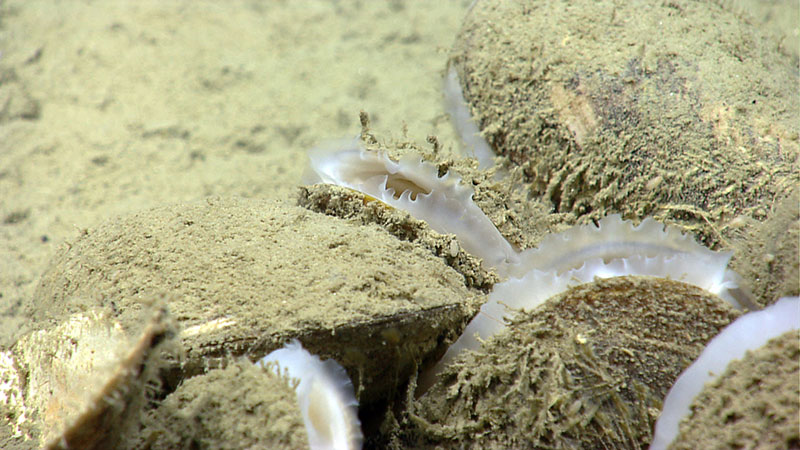We had a great dive today with the Deep Discoverer remotely operated vehicle (ROV), discovering active methane seeps and more chemosynthetic communities! The primary purpose of today's dive was to ground truth bubbles plumes in the water column detected by our multibeam sonar in 2012 (and again last night that suggest the presence of gas seeps in the area) as well as characterize diverse habitats that may exist within and outside potential seep areas. The ROV arrived on bottom at 1,475 meters, and began transiting upslope to our first potential seep target. Live and dead mussels in clumps and patches (some cases linear) were seen during transit, and at 1,450 meters a small angular chunk of methane hydrate was identified along with bacterial mats and more clumps of mussels. Sediments with a dark or black stained appearance were common, and at 1,447 meters, a few sparse methane bubbles were seen escaping holes in the seafloor. Continuing further upslope, a large mussel bed was discovered at 1,426 meters. Several patches of raised mussel mounds were conspicuous hosting white filamentous microbes growing on the mussel shells. Few fauna were observed among the mussels, but those present included a single individual of Alvinocaris shrimp and amphipods. A run across the approximately 6x9-meter wide mussel bed was conducted before continuing the dive. At 1,419 meter, we came across active and streaming bubbles emanating from multiple locations. Following a problem with a ship that pulled us off site, we returned to the seafloor and started a transit up slope to the third potential seep target, encountering white stained sediments, carbonate material and small patches of mussels. Finally, at 1,420 meters we discovered rapid and active bubbling. Methane hydrates were identified on the seafloor, and it was questioned whether some of the large patches of white material were hydrates and not bacterial mats. All in all, it was a great dive providing key new information about the utility of exploring bubble plumes from multibeam data, methane hydrate production in North Atlantic canyons, and cold seep communities in the region.
